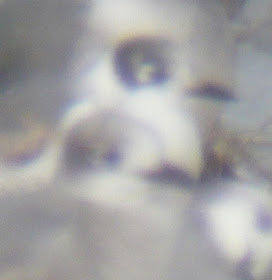 Today (12/27/2010), Mac Myers and I were conducting beach surveys in Cameron Parish. As we were traveling from Holly Beach to the Johnsons Bayou area, we saw a group of hawks soaring and kiting over the fields and marsh south of the highway. One obviously didn't look like a Red-tailed, so we stopped and made sure. It was indeed a Ferruginous Hawk, as we suspected: this was right across the highway from where James Beck had found a cooperative Ferruginous last October. That bird had allowed a lot of happy birders to add this species to their state lists, but as far as I can recall, it hadn't been reported since late October or so. Mac and I were pleased to have relocated it.
Today (12/27/2010), Mac Myers and I were conducting beach surveys in Cameron Parish. As we were traveling from Holly Beach to the Johnsons Bayou area, we saw a group of hawks soaring and kiting over the fields and marsh south of the highway. One obviously didn't look like a Red-tailed, so we stopped and made sure. It was indeed a Ferruginous Hawk, as we suspected: this was right across the highway from where James Beck had found a cooperative Ferruginous last October. That bird had allowed a lot of happy birders to add this species to their state lists, but as far as I can recall, it hadn't been reported since late October or so. Mac and I were pleased to have relocated it. We continued on our way, and a few minutes later we were at the end of Erbelding Road, about a mile west of where we'd seen the Ferruginous. There was another nice group of hawks there, at least seven visible at once. As we watched, another hawk materialized from the west, flying in fairly low. It was a Ferruginous Hawk.
We felt it was a different bird, as we'd left the other bird soaring a mile to the east. However, the wind was strong out of the southeast, so there was a chance it was the same bird, but had ridden downwind quickly and beaten us to the spot.
On the way back out from the beach a few hours later, we relocated the Ferruginous Hawk at the end of Erbelding Road. We kept an eye on it as we got back on the highway, and we headed back east a mile, making sure this bird didn't drift back to the original hawk spot. When we got back to the first site, we picked out a Ferruginous mixed with the redtails soaring well south of the highway, and convinced ourselves there really were two Ferruginous Hawks. But just to make sure, we headed back to Erbelding Road, looked up, and relocated Ferruginous Hawk #2.
This is the first time that I'm aware of that two Ferruginous Hawks have been reported in a day in Louisiana. With all of the food the hawk swarm along the coast must be finding to eat, I wouldn't be surprised if more good hawks find their way there.
























